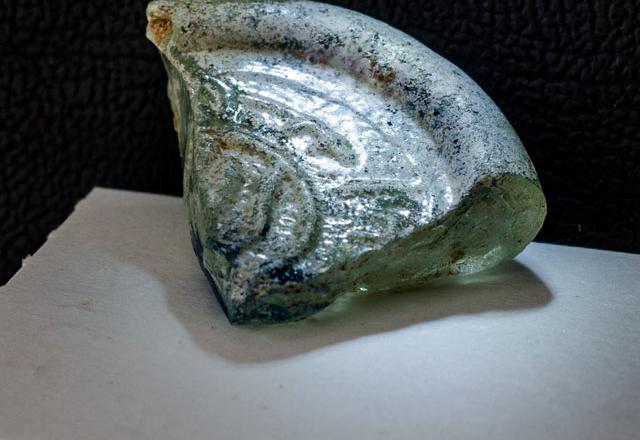You are here
‘Many theories but few answers’ surround glass disk found in Shobak — scholar
By Saeb Rawashdeh - Feb 07,2019 - Last updated at Feb 07,2019

A piece of the glass disk found in Shobak, which dates from the Ayyubid-Mamluk period can be seen in this undated photo (Photo courtesy of Elena Casalini)
AMMAN — A glass disk fragment found in Shobak poses many questions about the item’s origin and whether it was a part of an “Egyptian merchant set of glass weights”, or was produced in Damascus, according to an Italian scholar.
It could have been a crusader good luck token, an Italian scholar speculated, adding that it could have also been part of a wealthy Mamluk lord’s collection, or framed in a metal bracelet or necklace, like one housed at the Petra Museum.
Despite speculations, its presence in the Shobak area is important for enriching the list of non-Egyptian glass disks, noted Elena Casalini, a PhD candidate at the University of Rome.
“There are many theories but few answers,” Casalini continued, adding that in 1951 an expert in Islamic coins, George Miles, was one of the first scholars that tried to explain the use of the glass disks and was convinced that the disks were used as single-coin weights.
In other words, they measured and guaranteed the weight of a single coin for transactions, she explained, adding that one of the most important contributors to the study of glass disks was the late Paul Balog (1900-1982), who confirmed that during the Early Islamic period, the glass disk was, indeed, used for weighing coins.
However, the number and type of glass disks increased during Fatimid rule and later, during the Ayyubid period, Balog claimed, adding that copper in Egypt was overexploited.
On the other hand, Casalini said that another scholar, Michael Bates, claimed that the glass disks were used in bulk to weigh coins rather than individually.
“That’s also the reason why they have been so often recovered in groups or in the collapsed shops in Fustat: They were used in sets by merchants, and they were more practical to carry than the metal weights during long travels or pilgrimages,” the archaeologist, who was a member of the Italian archaeological mission in Jordan, underlined.
Regarding the object itself, the disk fragment found in 2007 is white glass and stained cobalt blue in the centre. Casalini noted that the fragment also bears a circular inscription that frames a central medallion, which is also inscribed.
“The readable part of the script may be transliterated as ‘Ibn’... [son of] and a name starting with a ‘lam’. The central medallion bears a ‘lam’ followed by an ‘alif’, which could be interpreted as the beginning of the ‘shahada’... but unfortunately is incomplete,” she stressed.
Furthermore, glass weights were made by impressing an inscribed stamp into a measured globule of glass while it was still in a semi-liquid state, she highlighted, noting that it emulates the layout of metal coins with text arranged in concentric rings.
“Glass weights came in many sizes, colours and denominations: They refer to the dinar and the dihram, but also to the ratl [pound] and the wuqiyya [ounce]. Therefore, they were regulated and used as a measure for many different items, from grains and olive oil to coins,” the scholar said, adding that coins were not always made of gold or silver.
For these reasons, in market transactions, the weight of precious metal coins would be measured on a balance against glass coins in order to determine a correct sum of money, she explained.
“Their common use in commercial affairs is recorded in several Geniza documents written by merchants who used the Arabic verb ‘to weigh’ as a synonym for ‘to pay’,” Casalini elaborated.
Glass weights seem to have been somehow inherited from both the occidental and oriental pre-Islamic world, she noted, adding that Byzantine glass weights were produced during the 6thand the first half of the 7thcentury AD.
After Muslim expansion in areas of the Middle East controlled by the Persian and Byzantine empires, Sassanian glass vessel stamps and exagia were still used, the archaeologist said.
“Detached stamps, from broken vessels, were found in Syria and Iraq, and Paul Balog acquired several of them in Egyptian antique shops. They represent humans, or animals, [both] real and mythical ones such as horses, birds and peacock-dragons,” Casalini said.
Related Articles
AMMAN — The government on Tuesday said it will study a request by the Jordan Free Zone Investor Commission (JFZIC) to the Prime Ministry cal
AMMAN — The Higher Education Council (HEC) on Tuesday raised the minimum average of the General Secondary Education Certificate Examination
Chief Complaint: A Country Doctor’s Tales of Life in GalileeHatim KanaanehUS: Just World Books, 2015Pp.















